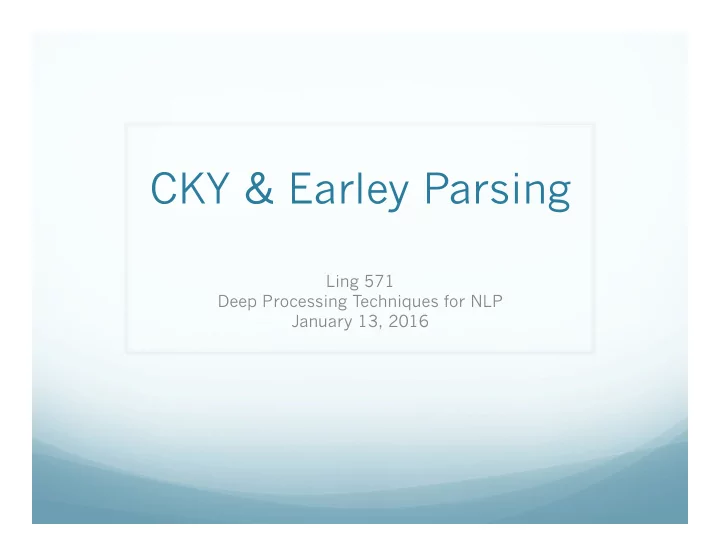

CKY & Earley Parsing Ling 571 Deep Processing Techniques for NLP January 13, 2016
No Class Monday: Martin Luther King Jr. Day
Roadmap CKY Parsing: Finish the parse Recognizer à Parser Earley parsing Motivation: CKY Strengths and Limitations Earley model: Efficient parsing with arbitrary grammars Procedures: Predictor, Scanner , Completer
0 Book 1 the 2 flight 3 through 4 Houston 5 Book the Flight Through Houston NN, VB, S, VP , X2 Nominal, VP , S [0,1] [0,2] [0,3] Det NP [1,2] [1,3] NN, Nominal [2,3]
0 Book 1 the 2 flight 3 through 4 Houston 5 Book the Flight Through Houston NN, VB, S, VP , X2 Nominal, VP , S [0,1] [0,2] [0,3] [0,4] Det NP [1,2] [1,3] [1,4] NN, Nominal [2,3] [2,4] Prep [3,4]
0 Book 1 the 2 flight 3 through 4 Houston 5 Book the Flight Through Houston NN, VB, S, VP , X2 Nominal, VP , S S, VP , X2 [0,1] [0,2] [0,3] [0,4] [0,5] Det NP NP [1,2] [1,3] [1,4] [1,5] NN, Nominal Nominal [2,3] [2,4] [2,5] Prep PP [3,4] [3,5] NNP , NP [4,5]
From Recognition to Parsing Limitations of current recognition algorithm: Only stores non-terminals in cell Not rules or cells corresponding to RHS Stores SETS of non-terminals Can’t store multiple rules with same LHS Parsing solution: All repeated versions of non-terminals Pair each non-terminal with pointers to cells Backpointers Last step: construct trees from back-pointers in [0,n]
Filling column 5
CKY Discussion Running time: where n is the length of the input string O ( n 3 ) Inner loop grows as square of # of non-terminals Expressiveness: As implemented, requires CNF Weakly equivalent to original grammar Doesn’t capture full original structure Back-conversion? Can do binarization, terminal conversion Unit non-terminals require change in CKY
Parsing Efficiently With arbitrary grammars Earley algorithm Top-down search Dynamic programming Tabulated partial solutions Some bottom-up constraints
Earley Parsing Avoid repeated work/recursion problem Dynamic programming Store partial parses in “ chart ” Compactly encodes ambiguity O ( N 3 ) Chart entries: Subtree for a single grammar rule Progress in completing subtree Position of subtree wrt input
Earley Algorithm First, left-to-right pass fills out a chart with N+1 states Think of chart entries as sitting between words in the input string, keeping track of states of the parse at these positions For each word position, chart contains set of states representing all partial parse trees generated to date. E.g. chart[0] contains all partial parse trees generated at the beginning of the sentence
Chart Entries Represent three types of constituents: predicted constituents in-progress constituents completed constituents
Parse Progress Represented by Dotted Rules Position of • indicates type of constituent 0 Book 1 that 2 flight 3 S → • VP , [0,0] (predicted) NP → Det • Nom, [1,2] (in progress) VP → V NP •, [0,3] (completed) [x,y] tells us what portion of the input is spanned so far by this rule Each State s i : <dotted rule>, [<back pointer>,<current position>]
0 Book 1 that 2 flight 3 S → • VP , [0,0] First 0 means S constituent begins at the start of input Second 0 means the dot here too So, this is a top-down prediction NP → Det • Nom, [1,2] the NP begins at position 1 the dot is at position 2 so, Det has been successfully parsed Nom predicted next
0 Book 1 that 2 flight 3 (continued) VP → V NP •, [0,3] Successful VP parse of entire input
Successful Parse Final answer found by looking at last entry in chart If entry resembles S → α • [0,N] then input parsed successfully Chart will also contain record of all possible parses of input string, given the grammar
Parsing Procedure for the Earley Algorithm Move through each set of states in order, applying one of three operators to each state: predictor: add predictions to the chart scanner: read input and add corresponding state to chart completer: move dot to right when new constituent found Results (new states) added to current or next set of states in chart No backtracking and no states removed: keep complete history of parse
States and State Sets Dotted Rule s i represented as <dotted rule>, [<back pointer>, <current position>] State Set S j to be a collection of states s i with the same <current position>.
Earley Algorithm from Book
Earley Algorithm from Book
3 Main Sub-Routines of Earley Algorithm • Predictor : Adds predictions into the chart. • Completer : Moves the dot to the right when new constituents are found. • Scanner : Reads the input words and enters states representing those words into the chart.
Predictor Intuition: create new state for top-down prediction of new phrase. Applied when non part-of-speech non- terminals are to the right of a dot: S → • VP [0,0] Adds new states to current chart One new state for each expansion of the non- terminal in the grammar VP → • V [0,0] VP → • V NP [0,0] Formally: S j : A → α · B β , [i,j] S j : B → · γ , [j,j]
Chart[0] Note that given a grammar, these entries are the same for all inputs; they can be pre-loaded. Speech and Language Processing - 1/13/16 Jurafsky and Martin
Recommend
More recommend